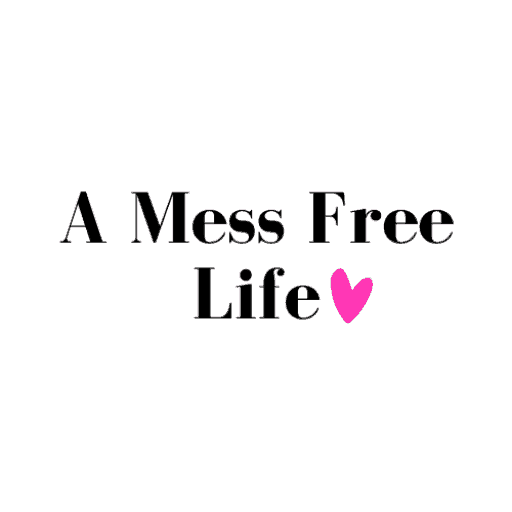A Mess Free Life may collect a share of sales or other compensation from the links on this page.

Are you struggling to get rid of the sentimental clutter in your home? Getting rid of the items cluttering up our homes can be hard, but decluttering can be even harder when the things you need to get rid of have memories and sentimental value attached to them. Let us show you how to move beyond the stress of dealing with a pile of sentimental clutter.
Table of Contents
What is sentimental clutter?
Sentimental clutter is any item that you no longer have a use for but can’t get rid of because the item has emotional significance and memories attached to it. What does sentimental clutter look like? Boxes of old family photos, old school dance dresses or suits, toys from childhood, and bone china that you inherited from your great aunt – you don’t have a use for these items anymore, but you feel like you can’t get rid of them because they hold memories for you.
Every time you go to deal with the clutter, you might feel guilt or sadness at the thought of giving these things away. One time, my mother-in-law called me to ask if we wanted some of my husband’s old toys. I said sure because our kids would love to play with their dad’s old toys. Later that day, she dropped off 10 trash bags full of stuffed animals! She hadn’t been able to bring herself to throw away anything my husband had owned as a kid. 10 trash bags of anything is too much, so I had to create my own system for dealing with sentimental clutter.
Let us help you deal with this difficult task and declutter sentimental items.
-
Keep your reason for decluttering in mind.
This process can be emotionally difficult, and you might find yourself losing confidence in your decision to do this. This is why it’s important to name to yourself why this process is important to you. Why are you feeling called to declutter your home?
Clutter is stressful. It takes up space in our homes, and it also takes up space in our minds. It’s been proven that clutter is bad for our mental health, and homes with less clutter are calmer and more peaceful. Homes without clutter are also more organized and easier to use. I’m not a minimalist, but it is true that minimalism has improved so many people’s lives.
When the going gets tough and your sentimental clutter triggers too many emotions, remind yourself that a cluttered home is a stressful home. What do you want from your clutter-free home? Maybe you want a peaceful refuge to come home to after a long day at work. Maybe you want to be able to invite friends over for coffee or dinner without spending an entire day speed cleaning.
Is the storage space in your home filled to the brim with mementos and nostalgia, so much so that you don’t have any room for the things you use on a daily basis?
Working to get rid of this sentimental clutter will be so worth it!
-
Name your clutter.
Before we get started tackling your specific clutter issues, we’ve got to wrap our heads around what we’re dealing with. What kind of items do you need to declutter?
Common sentimental clutter items:
- Photographs
- Clothing
- Books
- Computer discs with photos or videos
- Paper items like old school papers or kids artwork
- Old toys your mom saved or your own kids’ old toys
- Items inherited by family including jewelry, fine china, pottery, or artwork
- Baby memorabilia – blankets, toys, pacifiers, layette clothing
- a family heirloom that isn’t your style but you feel guilty getting rid of it
These are just a few examples of sentimental clutter items that can trip us up when it comes to getting our homes clutter free. Make a list of the items you need to deal with. Seeing the items on paper will make them feel less emotional. Once we see what items we need to deal with, we can get to work. Don’t skip this step because different types of items need different decluttering methods.
-
Photos
Photos can very easily become a clutter problem. We collect stacks and stacks of beloved photos of our family, and they can be some of our most treasured possessions. But if we don’t take care of them in the right way, they begin to clutter our homes. Luckily, photos are an easy fix when it comes to decluttering.
Do you have tons of photos in boxes gathering dust? I have two solutions.
Solution 1: Use them! Go buy some affordable picture frames and display your favorite photos on your walls or on a table. I have a table in my living room just for family photos. I love having some of my favorite pictures out where I can see them every day.
Solution 2: Store them the clutter-free way. Scan photos with a scanner and store them on the cloud. If this feels too high tech, there are lots of ways to learn how to use this system. Ask a friend to help, hire a service to do it for you, or watch a YouTube video on how to use the cloud storage system. Not only does this store your photos in a clutter-free way, it also protects them. If your home ever experiences a disaster emergency like a house fire or flooding, your most precious photos will be protected.
-
Use the container method.
With the container method, we keep the best and get rid of the rest. Let’s go back to my situation with the 10 garbage bags full of stuffed animals from my husband’s childhood. I wanted to keep his old toys for our kids to enjoy, but I didn’t have the space or mental energy to store what would probably be two hundred stuffed animals!
What did I do? I put the container method to use. This process comes from author and blogger Dana K. White from A Slob Comes Clean. Here’s how it works.
First, pick your container – a basket, a bin, a drawer, a shelf. For the stuffed animals, I chose to store them in a large basket. Next, I started filling the basket with stuffed animals one at a time starting with my kids’ favorite one, then the next favorite one, then the next favorite one.
When the basket was full, we stopped putting stuffed animals in the basket. Everything in the basket or container is what we are keeping. Everything out of the basket gets donated.
-
Use them up!
If you have a lot of sentimental clutter that can still be used, use it! If your grandma gave you beautiful china, set the table this weekend for a special meal on those plates. If you have a beloved collection of concert t-shirts, wear them. If they don’t fit your current style but you can’t bear to get rid of them, let your teenager wear them.
The sentimental clutter can turn into sentimental treasures if you can find space for them in your everyday life instead of storing them in boxes in the garage. If you have items that you can’t use everyday, these items should be easy declutter material.
-
Use a declutter box.
Fill a box of sentimental clutter items and seal it closed with tape. Put the box in the garage or the closet and don’t touch it for five or six weeks. Put “open box” on your calendar for six weeks from when you filled the box. When box opening day rolls around, try to remember what is in the box.
Can you remember what you put inside it? Chances are that you can’t remember what you put inside the box, and if that’s the case, whatever you do, do not open the box! Instead, put that box in the trash or take it to a donation station near you. Obviously the items don’t have as much emotional attachment as you thought.
If you can remember what was in the box but haven’t felt the need to open the box and take the things out, pause before you open the box. If you haven’t needed the items for six whole weeks, do you really need them? Be honest with yourself. If the box has remained sealed for over a month, it might be time to pass these items on.
-
Gift sentimental clutter to people who will love them.
If the thought of giving away your sentimental clutter is tripping you up, instead of donating them to a thrift store (a process that is very impersonal) consider seeking out people that will love the items and gifting it to them.
Let’s consider fine china dishes that you inherited from your grandmother. You aren’t using them and don’t have the space for them, but it makes you feel guilty to throw them away.
Vintage china sets are back in style, and I bet there is a young person getting started making their home who would love some fancy dishes for dinner parties. Giving your grandma’s china to a thrift store might make you feel sad and guilty, but gifting the dishes to a person who will love and cherish them can help you feel good about letting go.
-
Repurpose your sentimental clutter items.
Finding new ways to enjoy your sentimental items is a great way to turn these items from clutter into unique treasures.
Here are some ideas:
- Turn a collection of favorite old t-shirts into a quilt or pillow.
- Turn baby clothes into a stuffed animal.
- Almost any special item can be framed and displayed – jewelry, baby clothes, handkerchiefs, old tools like hammers or wrenches, almost anything! If it will fit in a frame or display case memory box, you can frame it.
- Use a lamp kit to turn an unused vase into a usable lamp.
- Hang china plates on a wall from a unique plate wall display.
The goal is to take items that are sitting in dusty boxes cluttering up your home and turn them into unique items that will make you smile every time you see them because of the memories they hold.
-
Ask a friend to help
If things start to feel too overwhelming and you find yourself unable to make decluttering decisions, maybe it’s time to phone a friend. Ask a friend you trust to come over and help you decide what stays and what goes. It’s really easy to be stuck when getting rid of sentimental clutter, and it can be emotionally exhausting. A friend can offer you a non-emotional, objective point of view.
-
Take baby steps and give yourself grace.
As with any cleaning and decluttering task, taking small steps towards your goals is the way to make lasting change. Getting rid of sentimental clutter can be a very emotional job, and that can be exhausting. Give yourself a huge dose of grace when dealing with these items. It might surprise you what emotions, negative and positive, are dragged up by dealing with old family items. Give yourself permission to feel all the feelings and take breaks when you need to.
Conclusion
Dealing with sentimental clutter items is hard! Use this list to help you work through the process. Working diligently through your clutter items, taking breaks, asking for help, and thinking outside the box on how these items can fit into your everyday life can help you deal with sentimental clutter.


